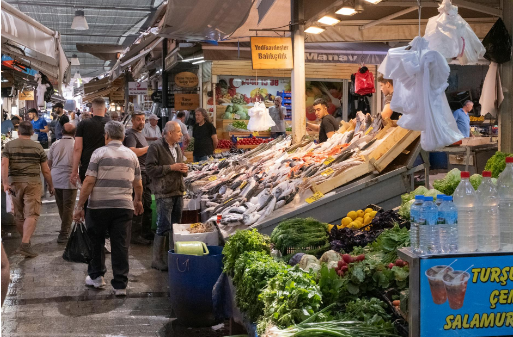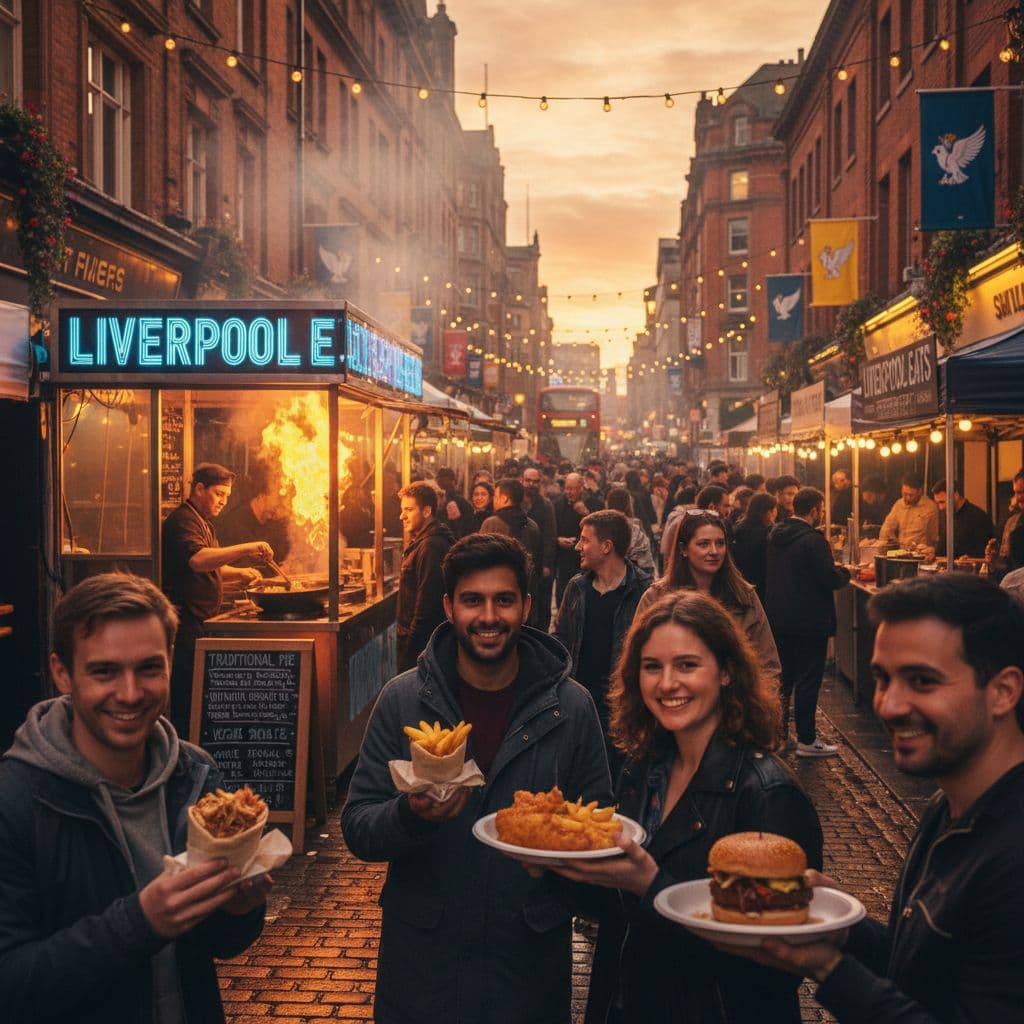The Ultimate Guide to Exploring Street Food blog in 2024
Exploring the vibrant world of street food is a culinary adventure that excites food lovers and travelers alike. Street food offers a unique taste of local culture, with each bite telling the story of its origins and traditions. Whether you’re navigating the bustling markets of Bangkok or the food trucks of Los Angeles, street food’s charm lies in its authenticity and diversity.
Why has street food become such a hot topic? It’s simple: it combines affordability, convenience, and bold flavors. As you venture through different cities, you’ll discover that each locale boasts its own street food gems, from savory tacos to sweet crepes. This blog will guide you through the must-try street foods, sharing insights on what makes each one special and where to find the best vendors. Get ready to embark on a flavorful journey that will enrich your palate and broaden your travel horizons.
The History of Street Food
Street food has a rich history that mirrors the evolution of human society. From ancient civilizations to bustling 20th-century cities, street food has been a constant companion, adapting to the changing world while maintaining its core essence. Let’s explore how it all began and how it rose to prominence in modern times.
Ancient Street Food
Did you know that street food has been around since ancient civilizations? Evidence of street food vendors traces back to Ancient Greece and Rome. In these bustling cities, vendors sold a variety of food items like olives, bread, and fried fish. These ancient street vendors played a crucial role in feeding the masses, especially those who couldn’t afford kitchen facilities at home.
- In Ancient Greece, it was common to find vendors selling small fried fish on street corners. These snacks were not just tasty but also affordable for the common people.
- Similarly, in Ancient Rome, street food vendors offered items like cooked meats, wine, and bread, making it easy for busy city dwellers to grab a quick bite.
Street food also had significant roles in other ancient cultures. For instance, in China, dim sum and dumplings were sold by street vendors and played a key role in the daily diet of ancient Chinese society. These food items were easy to carry and eat, making them ideal for workers and travelers.
Street Food in the 20th Century
The 20th century marked a major shift in the street food scene, driven by industrialization and urbanization. As cities grew and life became faster-paced, the demand for quick, affordable meals skyrocketed. Street food filled this demand perfectly.
 Photo by rabia kamer polat
Photo by rabia kamer polat
With the rise of industrialization, many families moved to urban areas, where street vendors became essential providers of ready-to-eat meals. Food trucks and street carts became common sights, offering everything from hot dogs and pretzels in New York City to tacos in Mexico City.
Here are a few key points about street food in the 20th century:
- Diversity Explosion: As cities became melting pots of cultures, so did the street food offerings. You could find a variety of cuisines from different cultures, all within a few blocks.
- Affordability: Street food remained an affordable option for the working class, providing hearty meals without breaking the bank.
- Convenience: The fast-paced urban lifestyle made the convenience of street food incredibly appealing. Workers could grab a quick, tasty meal between shifts.
Cities like Bangkok, New York, and Mexico City became famous for their vibrant street food scenes, attracting locals and tourists alike. This period also saw the rise of iconic street food items like New York’s hot dogs, Bangkok’s pad thai, and Mexico’s tacos, cementing their place in culinary history.
Street food has evolved from ancient times to the present day, adapting to societal changes while maintaining its core appeal: delicious, convenient, and affordable meals. Each bite not only tells a story of the present but also echoes the rich history of human civilization.
Popular Street Food Around the World
Street food is one of the best ways to experience a culture. Whether you’re wandering through busy markets in Thailand or bustling plazas in Mexico, the local food stalls offer a taste of authentic, everyday life. Let’s take a delicious tour of some popular street foods from different parts of the world.
Asia: A Culinary Paradise
Asia is a street food lover’s dream. The variety and flavors are endless, making it difficult to choose just a few highlights. Here are some must-try street foods from this vibrant region.
- Pad Thai: Originating from Thailand, Pad Thai is a stir-fried noodle dish that combines shrimp, tofu, peanuts, a scrambled egg, and bean sprouts, all cooked in a tangy tamarind sauce. It’s a harmonious blend of sweet, salty, and sour flavors.

Photo by Kampus Production
- Satay: Found in Indonesia, Malaysia, and Singapore, satay is skewered and grilled meat served with a peanut dipping sauce. The smoky, charred flavors of the meat combined with the rich, creamy sauce make for an unforgettable taste.
- Banh Mi: Vietnam’s answer to the sandwich, Banh Mi, is a French-Vietnamese fusion. A crispy baguette is filled with ingredients like pate, cold cuts, pickled vegetables, and fresh herbs. Banh Mi is a collision of textures and flavors — crunchy, tangy, savory, and spicy all in one bite.
For more on these delicious bites, you can read this article on Asian street foods.
Europe: A Taste of Tradition
Europe’s street food scene is deeply rooted in tradition, offering a rich tapestry of flavors that reflect the continent’s diverse cultures. Here are some iconic street foods that you shouldn’t miss.
- Crepes: Originating from France, crepes are thin pancakes that can be sweet or savory. Sweet crepes might be filled with sugar, Nutella, or fruits, while savory versions (known as galettes) often include ham, cheese, and eggs.
- Sausages: German and Polish streets are filled with the mouthwatering smell of grilled sausages. Bratwurst, a type of German sausage made from pork, beef, or veal, is often served with mustard and bread. In Poland, look for Kielbasa, a smoky and flavorful sausage.
- Poutine: While technically hailing from Canada, poutine has found a loving home in many parts of Europe. This dish features fries topped with cheese curds and hot gravy, creating a comfort food that’s hard to resist.
For a deeper dive into Europe’s street food, check out this guide to European street eats.
The Americas: A Flavorful Fusion
In the Americas, street food is all about bold flavors and creative combinations. From the savory to the sweet, here are some favorites that offer a taste of the different regions.
- Tacos: Mexico’s famous street food, tacos, are small corn or wheat tortillas filled with a variety of ingredients such as beef, chicken, beans, and fresh vegetables. They are often topped with salsa, lime, and cilantro.
- Arepas: Arepas are a staple in Venezuela and Colombia. These cornmeal cakes can be grilled, baked, or fried and are typically stuffed with cheese, meats, or avocado. They’re a perfect blend of crunchy and soft textures.
- Lobster Rolls: Originating from the coastal areas of the United States, particularly Maine, lobster rolls consist of lobster meat dressed with butter or mayonnaise and served in a toasted bun. This dish is a seafood lover’s dream come true.
For more on these flavorsome street foods, visit a comprehensive guide on American street food.
Street food is more than just a quick bite; it’s a window into the heart and soul of a culture. As you travel, be sure to explore the local street food scene — it’s an adventure for your taste buds.
Health and Safety in Street Food
Street food is a delightful way to explore local culture and flavors, but it’s essential to keep health and safety in mind. This section provides practical advice on how to select safe street food vendors and raises awareness about common foodborne illnesses, so you can enjoy delicious street treats without worry.

Photo by Sarah Chai
Identifying Safe Street Food Vendors
When scouting for street food, it’s important to select vendors who prioritize cleanliness and quality. Here are some tips to help you identify safe street food vendors:
- Cleanliness: Look for vendors who maintain a clean stall. The workspace should be free of clutter and trash, and surfaces should be wiped regularly.
- Protective Gear: Vendors should wear protective gear like gloves and hairnets. This shows they are taking steps to keep food safe.
- Fresh Ingredients: Check if the ingredients used appear fresh. Fresh produce and meats are less likely to be contaminated.
- Cooking Methods: Ensure the food is cooked thoroughly. Foods like meats and eggs should be well-cooked to prevent illnesses.
- Storage Practices: The vendor should store food properly. For instance, raw and cooked foods should be kept separately to avoid cross-contamination.
By following these tips, you can greatly reduce the risks associated with consuming street food. For more detailed tips on assessing street food safety, you can refer to this comprehensive guide on food safety.
Foodborne Illness Awareness
Eating street food can sometimes expose you to foodborne illnesses if not properly handled. Here are some common foodborne illnesses and prevention tips:
- Salmonella: Often found in undercooked poultry and eggs. Ensure these foods are cooked thoroughly.
- E. Coli: Can be present in contaminated water and undercooked meat. Avoid raw vegetables that may not have been washed properly.
- Listeria: Typically found in unpasteurized dairy products. Stick to pasteurized options when possible.
- Hepatitis A: Can spread via contaminated water and food. Opt for vendors who use purified water for cooking and cleaning.
Prevention tips include:
- Hand Hygiene: Always clean your hands before eating. Use hand sanitizers if soap and water aren’t available.
- Avoid Risky Foods: Be cautious with high-risk foods like raw oysters, sushi, and salads from questionable sources.
- Proper Temperature: Eating hot food is usually safer since heat can kill most pathogens.
For further reading on foodborne illnesses and their prevention, check out this informative page on foodborne pathogens.
By understanding these risks and how to avoid them, you can enjoy street food safely and healthily.
Cultural Impact of Street Food
Street food isn’t just about quick bites and tasty treats; it’s a window into cultural traditions and community values. It connects people across generations and backgrounds, fostering a sense of belonging and shared experience. Let’s explore how street food impacts culture through social experiences and its presence in festivals.
Street Food as a Social Experience
Street food has a unique way of bringing people together. Imagine bustling streets filled with sizzling pans and aromatic spices. People gather around food stalls, not only to satisfy hunger but to connect with others. It’s a communal activity that breaks down social barriers.
- Cultural Exchange: Street food markets are melting pots of cultural exchange. Locals and tourists alike experience diverse cuisines, gaining insight into different traditions and cooking techniques.
- Family Outings: It’s common for families to stroll through street food markets, sampling dishes from various vendors. These outings strengthen family bonds and create lasting memories.
- Friendship Building: Friends often meet up at popular street food spots, enjoying the casual ambiance and delicious food. It’s a low-pressure way to socialize and catch up.
 Photo by Ryutaro Tsukata
Photo by Ryutaro Tsukata
Street Food in Festivals and Events
At local festivals and cultural events, street food plays a starring role. It reflects the region’s identity and offers a taste of local heritage.
- Local Festivals: Events like the Chiang Mai Sunday Night Market in Thailand showcase traditional foods. Each vendor tells a story through their cuisine, revealing much about the area’s history and values.
- Seasonal Celebrations: Street food is often integral to seasonal celebrations. Think of the Lunar New Year in China, where specific dishes symbolize good luck and prosperity.
- Community Events: Street food vendors are mainstays at local fairs and community events, providing an affordable and convenient dining option for attendees. These events wouldn’t be the same without the familiar smells and tastes of street food.
Street food not only delivers delicious flavors but also fosters community ties and celebrates cultural diversity. Whether during a casual meet-up or a grand festival, street food acts as a bridge, bringing people together through shared culinary experiences.
The Rise of Gourmet Street Food
Street food has come a long way from its humble beginnings. What was once considered a quick, cheap, and convenient meal on the go has now evolved into a vibrant and gourmet dining experience. From the bustling streets of New York to the night markets in Bangkok, street food is capturing the hearts and appetites of foodies around the world. Let’s explore the elements that have contributed to this remarkable transformation.
Food Trucks and Culinary Innovation
 Photo by Julia Volk
Photo by Julia Volk
Food trucks have become an emblem of culinary innovation. These mobile kitchens have revolutionized the street food scene by offering creative dishes that compete with those of high-end restaurants.
- Mobility: They can park in crowded urban areas, festivals, and even suburban neighborhoods.
- Variety: Many food trucks focus on specific cuisines, from Korean BBQ to gourmet burgers, offering a wide range of options.
- Quality: High-quality ingredients and innovative cooking techniques have raised the bar for what street food can be.
Food trucks have also embraced the use of social media, allowing them to connect with their audience by sharing their locations and menus. This has created an interactive dining experience where patrons can follow their favorite food trucks, making it a community affair.
Check out this article on the rise of food trucks for more information on how they have impacted the culinary world.
Fusion Cuisine in Street Food
Fusion cuisine has opened up a new culinary world, blending flavors and techniques from different cultures to create something entirely unique. Street food vendors are at the forefront of this trend, offering dishes that are as diverse as they are delicious.
Popular fusion street food examples:
- Korean Tacos: A delightful mix of Korean BBQ and Mexican street tacos, featuring marinated beef, spicy kimchi, and tangy salsa.
- Sushi Burritos: Combining the best of Japanese and Mexican cuisines, these oversized sushi rolls are wrapped in seaweed and stuffed with fresh fish, rice, and various toppings.
- Butter Chicken Poutine: A Canadian classic meets Indian cuisine, with crispy fries topped with creamy butter chicken and cheese curds.
The appeal of fusion cuisine lies in its ability to surprise and delight the palate. By combining familiar ingredients in unfamiliar ways, these dishes offer a new dining experience that keeps people coming back for more. Curious about fusion food? Read more about it here.
The rise of gourmet street food is a testament to the creativity and entrepreneurial spirit of today’s food vendors. They are not just cooks; they are artists, innovators, and community builders, transforming the way we think about dining on the go. Stay tuned as we explore more trends in the gourmet street food revolution!
Tips for Enjoying Street Food
The Ultimate Guide to Exploring Street Food blog in 2024
Street food is a delightful way to explore new cultures and flavors. It’s often affordable, convenient, and delicious. To get the most out of your street food experience, here are some practical tips.
Choosing the Right Vendors
The Ultimate Guide to Exploring Street Food blog in 2024
 Photo by Doğan Alpaslan Demir
Photo by Doğan Alpaslan Demir
Finding the right vendor is key to enjoying high-quality street food. Here are some pointers to help you make the best choice:
- Look for Long Lines: Busy vendors are usually a good sign. If locals are willing to wait, it’s likely that the food is fresh and tasty.
- Check for Cleanliness: While street food doesn’t come with the same standards as a restaurant, some basic hygiene is essential. Clean hands, tidy stalls, and covered food items are positive indicators.
- Observe the Cooking Process: If the food is being cooked right in front of you, it’s less likely to be stale. Plus, you can see exactly what goes into your meal.
- Ask for Recommendations: If you’re unsure, just ask a local! They often know the best spots and can steer you clear of any notorious vendors.
For additional vendor selection tips, the guide Selecting the Best Street Food Vendors offers some valuable advice.
Pairing Drinks with Street Food
Pairing your street food with the right drink can greatly enhance your culinary experience. Here are some popular beverage options:
- Lemonade is fantastic with spicy dishes. The citrus cuts through the heat, providing a refreshing balance.
- Soda is a classic go-to. The carbonation can help cleanse your palate between different flavors.
- Tea or Chai often complements savory items well, especially if you’re enjoying Asian or Middle Eastern street food.
- Beer is quite versatile. A cold beer pairs wonderfully with greasy, fried snacks.
Whether you’re washing down a spicy taco or a savory samosa, your drink choice can make the meal even better. For more drink pairing ideas, check out perfect drinks to pair with street food.
Armed with these tips, you’ll be well-prepared to enjoy your next street food adventure to the fullest!
Conclusion
Street food is a vital part of global culture. It’s a way to experience local flavors and traditions that you can’t get in a formal restaurant.
Exploring your local street food scene can be an eye-opening experience. It supports small businesses and offers a taste of authentic cuisine.
Go out, try new dishes, and immerse yourself in the vibrant world of street food. Your taste buds will thank you.








Leave a Reply